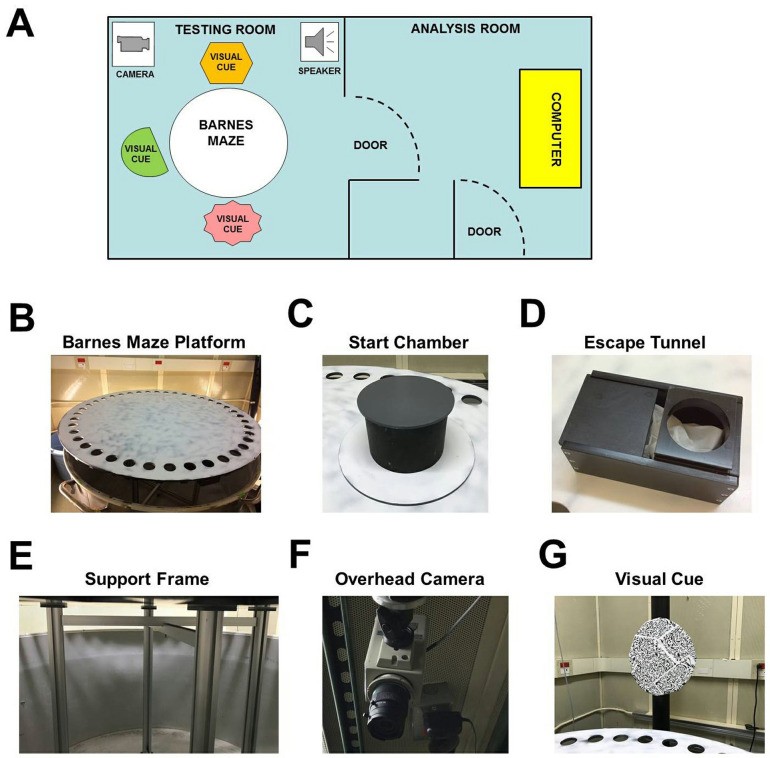Spatial Learning, the process by which we acquire and remember information about our environment’s spatial relationships, is a fundamental aspect of cognition. It allows organisms to navigate, find resources, and remember important locations. In neuroscience and behavioral research, understanding the mechanisms of spatial learning is crucial for studying memory, cognitive disorders, and the effects of various treatments on brain function. The Barnes maze is a powerful behavioral tool used extensively to assess spatial learning and memory in rodents, offering a less stressful and ethologically relevant alternative to other mazes like the Morris water maze. This article delves into the Barnes maze, its advantages, experimental setup, procedure, and data analysis, providing a comprehensive guide for researchers and educators interested in exploring spatial learning.
What is Spatial Learning?
Spatial learning is more than just knowing where things are; it’s about creating a cognitive map of the environment. This involves the hippocampus, a brain region critical for memory and spatial navigation. Animals and humans use spatial learning to orient themselves, remember routes, and locate places of significance. Deficits in spatial learning are observed in various neurological conditions, including Alzheimer’s disease and other forms of dementia, making its study vital for understanding and treating these conditions. Behavioral paradigms like mazes are designed to tap into this spatial learning ability, allowing researchers to measure and manipulate it under controlled experimental conditions.
The Barnes Maze: An Overview
The Barnes maze, developed by Carol Barnes, is a dry-land based circular platform designed to evaluate spatial learning and memory in rodents, primarily mice and rats. Unlike the Morris water maze, which relies on swimming as a motivator to escape, the Barnes maze leverages rodents’ natural aversion to open, brightly lit spaces. The apparatus consists of a raised circular platform with multiple holes around its perimeter. One of these holes leads to an escape tunnel, while the others are closed. Visual cues are placed around the maze to provide spatial references for the animal.
Figure 1. Barnes maze experimental setup. (A) Layout of behavioral testing room. (B-F) Components of the Barnes maze platform including the start chamber, escape tunnel, support frame, and overhead camera.
The principle behind the Barnes maze for assessing spatial learning is that rodents, motivated by the aversion to the open platform, will learn to locate the escape tunnel using the distal visual cues. Over repeated trials, a rodent with intact spatial learning abilities will progressively become more efficient at finding the escape hole.
Advantages of the Barnes Maze for Spatial Learning Research
While the Morris water maze has been a gold standard for spatial learning assessment, the Barnes maze offers distinct advantages, particularly in terms of animal welfare and behavioral specificity.
- Reduced Stress: The Barnes maze avoids the stress associated with swimming. Studies have shown that the Barnes maze elicits lower levels of corticosterone, a stress hormone, compared to the Morris water maze. This is crucial as stress can be a confounding factor in cognitive testing, potentially affecting spatial learning performance.
- No Thermoregulation Issues: Swimming in the Morris water maze can cause hypothermia in rodents, which can also impact cognitive function. The dry-land nature of the Barnes maze eliminates this concern, providing a more physiologically stable environment for assessing spatial learning.
- Ethological Relevance: The aversion to open spaces is a natural rodent behavior, making the Barnes maze a more ethologically relevant test compared to forced swimming. This can lead to more natural and reliable measures of spatial learning.
- Clear Search Strategy Analysis: The Barnes maze allows for detailed observation and categorization of search strategies employed by the animal during spatial learning. Researchers can distinguish between random searches, serial searches (systematically checking holes), and spatial searches (direct navigation to the escape hole), providing richer insights into the cognitive processes involved in spatial learning.
These advantages make the Barnes maze an excellent choice for researchers focused on spatial learning, especially when minimizing stress and understanding the nuances of search strategies are important considerations.
Barnes Maze Protocol: A Step-by-Step Guide
To effectively utilize the Barnes maze for spatial learning research, a standardized protocol is essential. Here’s a detailed guide based on established procedures:
Materials and Reagents
- Tissue paper
- 70% ethanol spray
- Adult male mice (typically C57BL/6J strain, 3-5 months old)
Equipment
- Well-lit testing room (~1,000 lux) with a separate holding room.
- Barnes maze apparatus:
- Circular platform with 40 holes and an escape tunnel.
- Overhead camera.
- Distal visual cues (at least three).
- Loudspeaker for white noise (optional, for added motivation).
- Computer with video tracking software.
- Tally counter.
Software
- Video tracking software (e.g., TSE VideoMot2)
- GraphPad Prism or similar statistical software
- Microsoft Excel
Procedure
The Barnes maze procedure for assessing spatial learning typically involves habituation, training, and probe trials.
-
Habituation (Day 1):
- Place the mouse in the start chamber in the center of the maze for a brief period (e.g., 1-2 minutes) to acclimate to the environment.
- Gently guide the mouse to the escape tunnel, allowing it to enter and remain there for a short time. This familiarizes the mouse with the escape location and reinforces it as a safe haven.
-
Training Trials (Days 2-5):
- Position distal visual cues consistently around the maze.
- For each trial, place the mouse in the start chamber in the center of the maze.
- Start the video recording and remove the start chamber. Simultaneously, you can initiate a white noise stimulus if used.
- Allow the mouse to explore the maze and find the escape tunnel.
- If the mouse finds the escape tunnel, allow it to stay there for 1-2 minutes.
- If the mouse does not find the escape tunnel within a set time limit (e.g., 3 minutes), gently guide it to the escape tunnel.
- Record the time to reach the escape tunnel (latency), the number of errors (incorrect hole checks), and the path length.
- Clean the maze with 70% ethanol and tissue paper between trials to eliminate olfactory cues.
- Conduct multiple trials per day (e.g., 4 trials) with inter-trial intervals (e.g., 15-30 minutes). Vary the starting position across trials to prevent place learning based on starting point, but keep the escape tunnel location constant for spatial learning.
Figure 2. Screenshot of VideoMot2 analysis software. This software is used for tracking and analyzing rodent behavior in the Barnes maze.
- Probe Trial (Day 6 or later):
- Remove the escape tunnel.
- Place the mouse in the start chamber and allow it to explore the maze for a set time (e.g., 90 seconds).
- Record the time spent searching around the target hole location and the number of times the mouse checks the target hole area.
- This probe trial assesses spatial memory retention, as a mouse that has learned the spatial location will preferentially search around the area where the escape tunnel was previously located.
Figure 3. Barnes maze procedure. (A) Experimental timeline. (B-D) Images depicting a mouse being released, checking holes, and entering the escape tunnel during a trial.
Data Analysis
Data analysis in the Barnes maze focuses on quantifying spatial learning and memory performance. Key metrics include:
- Latency to Escape: The time taken to find the escape tunnel. Decreases in latency over training trials indicate spatial learning.
- Errors: The number of incorrect hole checks before finding the escape tunnel. Reduction in errors reflects improved spatial learning.
- Path Length: The total distance traveled to reach the escape tunnel. Shorter path lengths suggest more efficient spatial learning.
- Search Strategy: Categorization of search patterns (random, serial, spatial). The progression from random/serial to spatial search strategies signifies effective spatial learning. In probe trials, time spent and entries around the target hole are crucial indicators of spatial memory.
Figure 4. Barnes maze search strategy. Tracking data examples illustrating (A) random, (B) serial, and (C) spatial search patterns during Barnes maze trials.
Video tracking software automates the collection of latency, errors, and path length data. Search strategies can be scored manually by trained observers or using automated algorithms. Statistical analysis (e.g., ANOVA, t-tests) is used to compare performance between groups and across training days to determine the effects of experimental manipulations on spatial learning.
### Video 1. Spatial search strategy.
[Download video file](/articles/instance/8203989/bin/BioProtoc-8-05-2744-m001.mp4) (16.6MB, mp4)### Video 2. Serial search strategy.
[Download video file](/articles/instance/8203989/bin/BioProtoc-8-05-2744-m002.mp4) (4.1MB, mp4)### Video 3. Random search strategy.
[Download video file](/articles/instance/8203989/bin/BioProtoc-8-05-2744-m003.mp4) (9.2MB, mp4)Data Presentation
Data from Barnes maze experiments are typically presented graphically to visualize spatial learning curves. Line graphs showing the mean latency, errors, or path length across training blocks effectively illustrate the learning process. Bar graphs are suitable for comparing group differences in probe trial performance or overall learning acquisition. Statistical significance should be indicated on graphs to support conclusions about spatial learning and memory.
Figure 5. Barnes maze data presentation. Graphs showing measures of (A) primary latency, (B) primary errors, and (C) primary hole distance comparing wild-type and knockout mice performance during Barnes maze training.
Applications of Spatial Learning Studies with Barnes Maze
The Barnes maze is a versatile tool applicable across various research areas related to spatial learning:
- Drug Discovery: Evaluating the effects of pharmacological interventions on spatial learning and memory enhancement or impairment.
- Genetic Studies: Assessing the role of specific genes in spatial learning by testing knockout or transgenic animal models.
- Aging Research: Investigating age-related decline in spatial learning and the effectiveness of interventions to mitigate cognitive aging.
- Environmental Enrichment Studies: Examining how enriched environments impact spatial learning and cognitive development.
- Disease Modeling: Studying spatial learning deficits in animal models of neurological disorders like Alzheimer’s disease, Huntington’s disease, and schizophrenia.
Conclusion
The Barnes maze is a robust and valuable behavioral assay for studying spatial learning and memory in rodents. Its dry-land, low-stress nature, combined with the ability to analyze search strategies, makes it a superior alternative to the Morris water maze in many experimental contexts. By understanding the principles, procedures, and data analysis methods of the Barnes maze, researchers can effectively investigate the complexities of spatial learning and contribute to advancements in neuroscience and the understanding of cognitive function. For further detailed protocols and applications, researchers are encouraged to consult the original publications and related literature using the Barnes maze for spatial learning research.
References
- Bach et al., 1995
- Barnes, 1979
- Harrison et al., 2009
- Iivonen et al., 2003
- Morris, 1984
- Pitts et al., 2013
- Pitts et al., 2015
- Porsolt et al., 1977
(Note: For a complete list of references, please refer back to the original article provided as the source material.)

